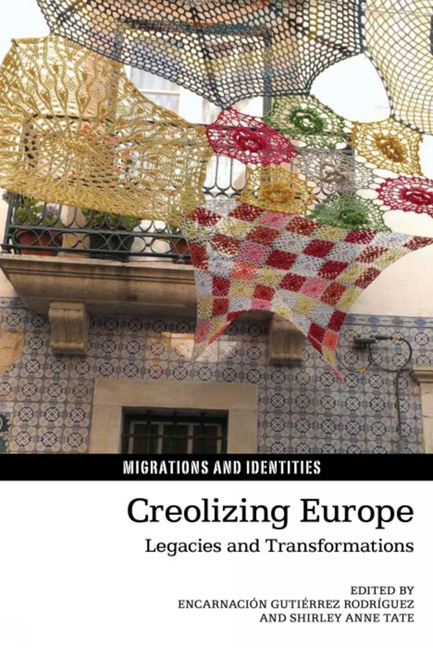Book contents
- Frontmatter
- Dedication
- Acknowledgements
- Contents
- List of Figures
- List of Contributors
- Introduction: Creolizing Europe: Legacies and Transformations
- 1 Creolité and the Process of Creolization
- 2 World Systems and the Creole, Rethought
- 3 Creolization and Resistance
- 4 Continental Creolization: French Exclusion through a Glissantian Prism
- 5 Archipelago Europe: On Creolizing Conviviality
- 6 Are We All Creoles? ‘Sable-Saffron’ Venus, Rachel Christie and Aesthetic Creolization
- 7 Re-imagining Manchester as a Queer and Haptic Brown Atlantic Space
- 8 Queering Diaspora Space, Creolizing Counter-Publics: On British South Asian Gay and Bisexual Men's Negotiations of Sexuality, Intimacy and Marriage
- 9 On Being Portuguese: Luso-tropicalism, Migrations and the Politics of Citizenship
- 10 Comics, Dolls and the Disavowal of Racism: Learning from Mexican Mestizaje
- 11 Creolizing Citizenship? Migrant Women from Turkey as Subjects of Agency
- Index
11 - Creolizing Citizenship? Migrant Women from Turkey as Subjects of Agency
- Frontmatter
- Dedication
- Acknowledgements
- Contents
- List of Figures
- List of Contributors
- Introduction: Creolizing Europe: Legacies and Transformations
- 1 Creolité and the Process of Creolization
- 2 World Systems and the Creole, Rethought
- 3 Creolization and Resistance
- 4 Continental Creolization: French Exclusion through a Glissantian Prism
- 5 Archipelago Europe: On Creolizing Conviviality
- 6 Are We All Creoles? ‘Sable-Saffron’ Venus, Rachel Christie and Aesthetic Creolization
- 7 Re-imagining Manchester as a Queer and Haptic Brown Atlantic Space
- 8 Queering Diaspora Space, Creolizing Counter-Publics: On British South Asian Gay and Bisexual Men's Negotiations of Sexuality, Intimacy and Marriage
- 9 On Being Portuguese: Luso-tropicalism, Migrations and the Politics of Citizenship
- 10 Comics, Dolls and the Disavowal of Racism: Learning from Mexican Mestizaje
- 11 Creolizing Citizenship? Migrant Women from Turkey as Subjects of Agency
- Index
Summary
Introduction
The notion of creolization explores cultural and linguistic mixing that stems from the encounters of cultures in the same location. It is usually taken to refer to historical colonial and postcolonial experiences in the Caribbean and Latin America. The historical experience and contemporary legacy of creolization in Latin America and the Caribbean is intricately bound up with slavery, settler colonialism, racialized and gendered violence. While the question of how far the term can be applied to other social, geographic and historical contexts is contested (Hannerz, 2002; Hall, 2003a; 2003b; Palmié, 2006; Knorr, 2010), I take some inspiration from the analytical aspects of the concept for exploring the European context of the early twenty-first century. Creolization as transculturation produces an ‘indigenous vernacular space, marked by the fusion of cultural elements drawn from all originating cultures, but resulting in a configuration in which these elements, though never equal, can no longer be disaggregated […] but have been permanently “translated”’ (Hall, 2003a, 31). One analytic aspect of the concept of creolization that I am particularly interested in here is the way in which cultural mixing is understood as productive of notions of belonging to the new locality: ‘creolization was always linked with indigenization’ (Knorr, 2010, 733). While Knorr suggests that creolization encompasses both ethnic and trans-ethnic identifications, and therefore tends to be inclusive (737), I deviate from Knorr who argues for reserving the notion of creolization only for the constitution of finite, distinct, Creole ethnic groups. Instead, the analytic potential of the concept of creolization is that it challenges assumptions of ethnic and cultural boundedness (Hall, 2003a; 2003b). Hannerz (2002, 14) proposes that the concept of creolization is particularly suited to ‘integrate cultural with social analysis’. However, when exploring the concept of creolization in the context of migration to Europe, it is important to be clear that any appreciation of the productive, culturally and socially democratizing aspects of creolization cannot be abstracted from the realities of oppression, violence and genocide.
- Type
- Chapter
- Information
- Creolizing EuropeLegacies and Transformations, pp. 202 - 221Publisher: Liverpool University PressPrint publication year: 2015

